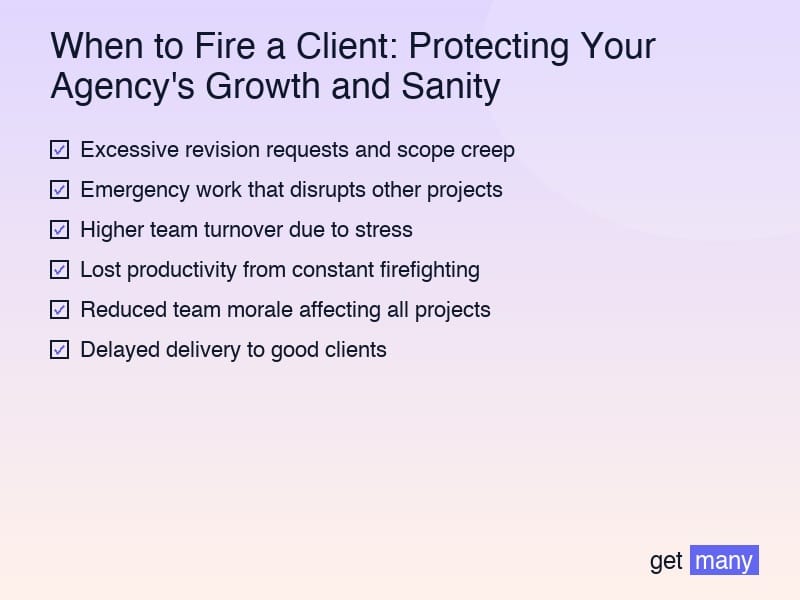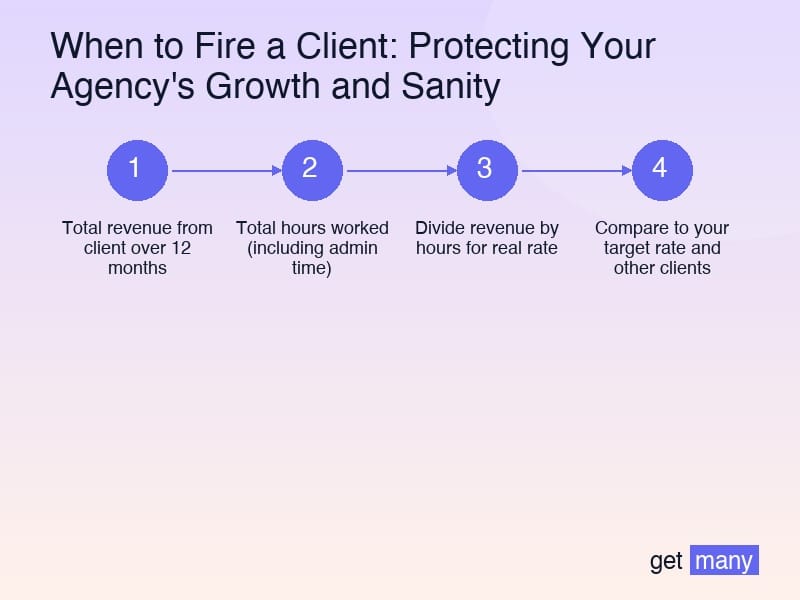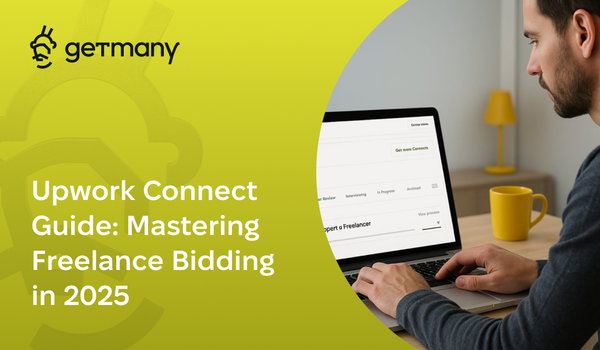When to Fire a Client: Protecting Your Agency's Growth and Sanity
Not all clients are worth keeping. Learn the data-driven framework for identifying toxic clients and the professional process for ending relationships.
The hardest lesson in agency growth is learning to say no to money. Every agency owner faces this moment: a client who pays well but drains your team, kills morale, and ultimately hurts your business. The question isn't whether you should fire clients—it's knowing when and how to do it professionally.
After analyzing 500+ client relationships and their impact on agency performance, I've developed a systematic framework for identifying when a client relationship has become toxic and the professional process for ending it. This isn't about being difficult—it's about protecting your agency's ability to grow and serve your best clients effectively.
The Hidden Cost of Toxic Clients

Beyond the Obvious Red Flags
Most agency owners recognize obvious problem clients: those who don't pay, abuse team members, or make unreasonable demands. But the most dangerous clients are the subtle toxins—those who seem fine on the surface but slowly poison your agency's growth.
The True Cost Calculation
Direct costs:
- Excessive revision requests and scope creep
- Emergency work that disrupts other projects
- Higher team turnover due to stress
- Lost productivity from constant firefighting
Indirect costs:
- Reduced team morale affecting all projects
- Delayed delivery to good clients
- Missed opportunities due to time drain
- Reputation damage from stressed team output
Opportunity costs:
- Time not spent on better clients
- Energy not invested in business development
- Team capacity not available for growth
- Mental bandwidth consumed by problems
The 80/20 Rule of Client Problems
Research shows: 80% of client problems come from 20% of clients. These toxic relationships consume disproportionate resources while contributing minimal value to your agency's growth.
The Client Evaluation Framework

The PROFIT Assessment
Use this systematic approach to evaluate every client relationship:
P - Profitability
- Does this client generate acceptable margins?
- Are they profitable after accounting for stress and complexity?
- Do they pay promptly and dispute invoices?
R - Respect
- Do they respect your expertise and recommendations?
- Are interactions professional and courteous?
- Do they honor agreements and boundaries?
O - Opportunity
- Does this relationship create growth opportunities?
- Are there referral or expansion possibilities?
- Does the work enhance your portfolio?
F - Fit
- Are they a good fit for your agency's capabilities?
- Do they align with your values and working style?
- Are their expectations realistic and achievable?
I - Impact
- What's the impact on team morale and productivity?
- How does this relationship affect other clients?
- Are they helping or hindering your reputation?
T - Time
- Do they consume disproportionate time and energy?
- Are they efficient in communication and decision-making?
- Do they create unnecessary urgency and stress?
The Red Flag Scoring System
Rate each factor 1-5 (5 being excellent, 1 being terrible)
Score interpretation:
- 24-30: Excellent client, prioritize retention
- 18-23: Good client, maintain relationship
- 12-17: Marginal client, consider improvement or exit
- 6-11: Problem client, plan exit strategy
- Below 6: Toxic client, exit immediately
Categories of Clients to Fire

Category 1: The Scope Creep Specialists
Characteristics:
- Constantly request "small additions"
- Redefine project requirements mid-stream
- Expect extra work without additional compensation
- Use phrases like "this should be easy" or "just a quick change"
Impact: Destroys project profitability and team morale
Category 2: The Micromanagers
Characteristics:
- Want to control every detail of execution
- Require approval for minor decisions
- Schedule excessive check-in meetings
- Don't trust your expertise or processes
Impact: Slows progress and prevents efficient workflow
Category 3: The Emergency Creators
Characteristics:
- Everything is urgent and last-minute
- Poor planning creates artificial deadlines
- Expect immediate availability for non-emergencies
- Disrupt schedules with constant "rush" requests
Impact: Stresses team and disrupts other client work
Category 4: The Payment Problems
Characteristics:
- Consistently late payments
- Dispute reasonable charges
- Negotiate prices after work is completed
- Create payment terms that hurt cash flow
Impact: Threatens financial stability and growth
Category 5: The Team Toxins
Characteristics:
- Rude or abusive to team members
- Unrealistic expectations and constant criticism
- Blame others for their own mistakes
- Create hostile working environment
Impact: Destroys team morale and increases turnover
Category 6: The Reputation Risks
Characteristics:
- Work in questionable industries or practices
- Make requests that compromise your standards
- Association could damage your reputation
- Expect you to cut corners or bend rules
Impact: Threatens long-term business reputation
The Data-Driven Decision Process
Client Profitability Analysis
Calculate true hourly rate:
- Total revenue from client over 12 months
- Total hours worked (including admin time)
- Divide revenue by hours for real rate
- Compare to your target rate and other clients
Example calculation:
- Annual revenue: $24,000
- Total hours: 300 (including all team time)
- True rate: $80/hour
- If your target rate is $100/hour, this client is unprofitable
Team Impact Assessment
Survey your team monthly:
- Client satisfaction ratings (1-10)
- Stress levels working with each client
- Preferred vs. avoided clients
- Impact on work-life balance
Red flags in team feedback:
- Consistent low satisfaction scores
- High stress levels
- Avoidance behavior
- Complaints about specific clients
Opportunity Cost Calculation
Questions to ask:
- What could we accomplish with this time?
- What better clients could we serve?
- What growth opportunities are we missing?
- What's the cost of team turnover?
The Professional Exit Process
Step 1: Documentation and Preparation
Gather evidence:
- Communication records
- Project history
- Payment records
- Team feedback
- Contract terms
Prepare legally:
- Review contract termination clauses
- Ensure all deliverables are current
- Prepare final invoices
- Plan transition timeline
Step 2: The Termination Conversation
Timing: Choose a moment when emotions are calm Method: Phone call followed by written confirmation Tone: Professional, respectful, firm
Script framework: "After careful consideration, we've decided that our agency isn't the best fit for your needs going forward. We'll complete [current project/timeline] and ensure a smooth transition."
Step 3: Transition Management
Immediate actions:
- Complete current work professionally
- Provide all necessary files and documentation
- Offer transition support (for reasonable fee)
- Maintain professional communication
Follow-up:
- Send written confirmation of termination
- Provide final invoices
- Complete any contractual obligations
- Offer referrals to other providers if appropriate
Advanced Termination Strategies
The Gradual Fade
When to use: Non-toxic clients who aren't profitable Process: Gradually reduce availability and increase rates Outcome: Client self-selects out of relationship
The Rate Increase Method
When to use: Marginally profitable clients Process: Increase rates to profitable levels Outcome: Client either pays fairly or leaves
The Scope Reduction
When to use: Clients with expanding scope problems Process: Reduce scope to original agreements Outcome: Client respects boundaries or finds new provider
The Immediate Termination
When to use: Toxic or abusive clients Process: End relationship immediately with proper notice Outcome: Protect team and agency reputation
Common Termination Mistakes
Mistake 1: Waiting Too Long
Problem: Hoping toxic clients will change Solution: Set clear deadlines for improvement
Mistake 2: Emotional Decisions
Problem: Terminating clients in anger Solution: Use systematic evaluation process
Mistake 3: Inadequate Documentation
Problem: No record of problems or communications Solution: Maintain detailed client interaction records
Mistake 4: Unprofessional Exit
Problem: Burning bridges with angry termination Solution: Maintain professionalism throughout
Mistake 5: No Replacement Strategy
Problem: Firing clients without revenue replacement Solution: Plan new client acquisition before termination
Building Termination Resistance
Client Qualification Process
Prevent toxic clients through better screening:
- Detailed discovery process
- Clear expectation setting
- Contract terms that protect you
- Trial periods for new relationships
Boundary Setting
Establish clear boundaries from the start:
- Communication protocols
- Scope change procedures
- Emergency vs. routine work definitions
- Payment terms and consequences
Regular Client Reviews
Quarterly client assessments:
- Profitability analysis
- Team satisfaction surveys
- Relationship health evaluation
- Improvement or exit planning
The Financial Impact of Client Termination
Short-Term Financial Planning
Prepare for revenue loss:
- Build cash reserves before termination
- Plan replacement client acquisition
- Adjust team capacity accordingly
- Maintain financial stability
Long-Term Financial Benefits
Improved profitability:
- Higher average project margins
- Reduced operational stress
- Better team productivity
- Increased client satisfaction
ROI of Termination
Calculate the return on investment:
- Time freed up for better clients
- Reduced stress and turnover costs
- Improved team performance
- Enhanced reputation and referrals
The Getmany Advantage in Client Replacement
Terminating clients creates immediate revenue gaps. Getmany helps fill these gaps by:
Accelerated prospecting: Find replacement clients faster Quality targeting: Identify clients who match your ideal profile Efficient proposals: Reduce time to close new business Portfolio optimization: Build better client relationships
This automation ensures you can afford to fire bad clients because you can replace them with better ones quickly.
Building a Termination-Resistant Agency
The Ideal Client Profile
Develop clear criteria for ideal clients:
- Industry and company size preferences
- Budget and timeline expectations
- Communication style requirements
- Growth and partnership potential
Premium Positioning
Attract better clients through positioning:
- Thought leadership content
- Case study development
- Referral program optimization
- Premium pricing strategies
Systems and Processes
Create systems that prevent toxic relationships:
- Detailed onboarding processes
- Regular check-ins and feedback
- Clear escalation procedures
- Performance monitoring systems
Your Client Portfolio Optimization Plan
Month 1: Assessment
- Complete PROFIT assessment for all clients
- Identify toxic and marginal relationships
- Calculate true profitability for each client
- Survey team for satisfaction feedback
Month 2: Strategy Development
- Plan termination approach for toxic clients
- Develop improvement plans for marginal clients
- Create ideal client profile
- Build replacement client pipeline
Month 3: Implementation
- Begin termination process for toxic clients
- Implement improvement plans for marginal clients
- Launch enhanced client acquisition efforts
- Monitor and adjust strategies
Month 4-6: Optimization
- Complete client portfolio transformation
- Measure impact on profitability and morale
- Refine client qualification processes
- Build systems to prevent future toxicity
The Bottom Line
Firing clients is one of the most important skills for agency growth. It's not about being difficult or picky—it's about protecting your agency's ability to serve your best clients effectively and grow sustainably.
The agencies that thrive are those that ruthlessly protect their capacity and energy for clients who value their work, pay fairly, and contribute to positive team morale. They understand that saying no to bad clients is saying yes to better opportunities.
Remember: You can't build a great agency by accepting mediocre clients. Every toxic relationship you maintain is an opportunity cost that prevents you from serving better clients and growing your business.
Your team's well-being, your agency's reputation, and your personal sanity are worth more than any individual client's revenue. Have the courage to fire clients who don't serve your long-term success.
Ready to build a portfolio of ideal clients? Getmany can help you identify and attract the right clients while building systems to maintain professional relationships. Start optimizing your client portfolio today and focus on the relationships that fuel your growth.





